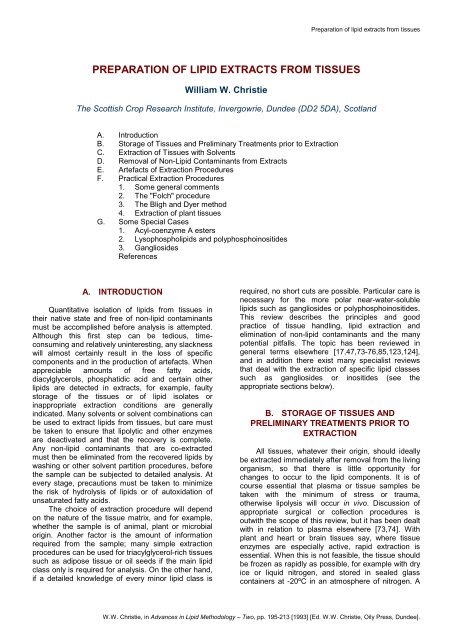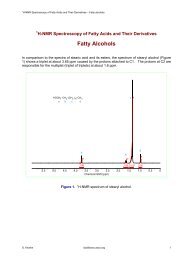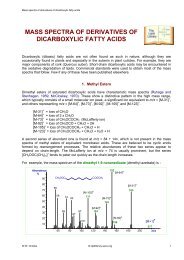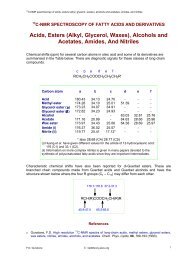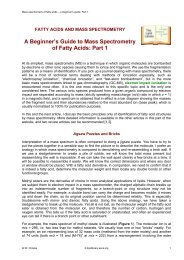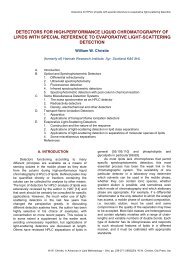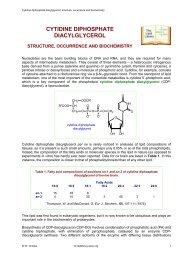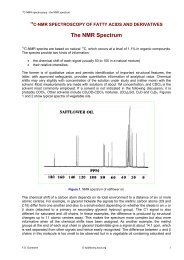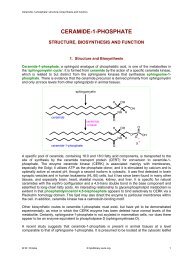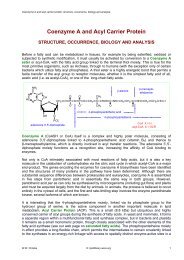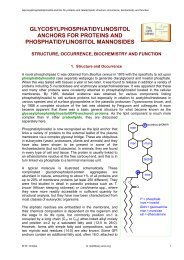Extraction of Lipids from Tissues - Lipid Library
Extraction of Lipids from Tissues - Lipid Library
Extraction of Lipids from Tissues - Lipid Library
You also want an ePaper? Increase the reach of your titles
YUMPU automatically turns print PDFs into web optimized ePapers that Google loves.
PREPARATION OF LIPID EXTRACTS FROM TISSUES<br />
William W. Christie<br />
Preparation <strong>of</strong> lipid extracts <strong>from</strong> tissues<br />
The Scottish Crop Research Institute, Invergowrie, Dundee (DD2 5DA), Scotland<br />
A. Introduction<br />
B. Storage <strong>of</strong> <strong>Tissues</strong> and Preliminary Treatments prior to <strong>Extraction</strong><br />
C. <strong>Extraction</strong> <strong>of</strong> <strong>Tissues</strong> with Solvents<br />
D. Removal <strong>of</strong> Non-<strong>Lipid</strong> Contaminants <strong>from</strong> Extracts<br />
E. Artefacts <strong>of</strong> <strong>Extraction</strong> Procedures<br />
F. Practical <strong>Extraction</strong> Procedures<br />
1. Some general comments<br />
2. The "Folch" procedure<br />
3. The Bligh and Dyer method<br />
4. <strong>Extraction</strong> <strong>of</strong> plant tissues<br />
G. Some Special Cases<br />
1. Acyl-coenzyme A esters<br />
2. Lysophospholipids and polyphosphoinositides<br />
3. Gangliosides<br />
References<br />
A. INTRODUCTION<br />
Quantitative isolation <strong>of</strong> lipids <strong>from</strong> tissues in<br />
their native state and free <strong>of</strong> non-lipid contaminants<br />
must be accomplished before analysis is attempted.<br />
Although this first step can be tedious, timeconsuming<br />
and relatively uninteresting, any slackness<br />
will almost certainly result in the loss <strong>of</strong> specific<br />
components and in the production <strong>of</strong> artefacts. When<br />
appreciable amounts <strong>of</strong> free fatty acids,<br />
diacylglycerols, phosphatidic acid and certain other<br />
lipids are detected in extracts, for example, faulty<br />
storage <strong>of</strong> the tissues or <strong>of</strong> lipid isolates or<br />
inappropriate extraction conditions are generally<br />
indicated. Many solvents or solvent combinations can<br />
be used to extract lipids <strong>from</strong> tissues, but care must<br />
be taken to ensure that lipolytic and other enzymes<br />
are deactivated and that the recovery is complete.<br />
Any non-lipid contaminants that are co-extracted<br />
must then be eliminated <strong>from</strong> the recovered lipids by<br />
washing or other solvent partition procedures, before<br />
the sample can be subjected to detailed analysis. At<br />
every stage, precautions must be taken to minimize<br />
the risk <strong>of</strong> hydrolysis <strong>of</strong> lipids or <strong>of</strong> autoxidation <strong>of</strong><br />
unsaturated fatty acids.<br />
The choice <strong>of</strong> extraction procedure will depend<br />
on the nature <strong>of</strong> the tissue matrix, and for example,<br />
whether the sample is <strong>of</strong> animal, plant or microbial<br />
origin. Another factor is the amount <strong>of</strong> information<br />
required <strong>from</strong> the sample; many simple extraction<br />
procedures can be used for triacylglycerol-rich tissues<br />
such as adipose tissue or oil seeds if the main lipid<br />
class only is required for analysis. On the other hand,<br />
if a detailed knowledge <strong>of</strong> every minor lipid class is<br />
required, no short cuts are possible. Particular care is<br />
necessary for the more polar near-water-soluble<br />
lipids such as gangliosides or polyphosphoinositides.<br />
This review describes the principles and good<br />
practice <strong>of</strong> tissue handling, lipid extraction and<br />
elimination <strong>of</strong> non-lipid contaminants and the many<br />
potential pitfalls. The topic has been reviewed in<br />
general terms elsewhere [17,47,73-76,85,123,124],<br />
and in addition there exist many specialist reviews<br />
that deal with the extraction <strong>of</strong> specific lipid classes<br />
such as gangliosides or inositides (see the<br />
appropriate sections below).<br />
B. STORAGE OF TISSUES AND<br />
PRELIMINARY TREATMENTS PRIOR TO<br />
EXTRACTION<br />
All tissues, whatever their origin, should ideally<br />
be extracted immediately after removal <strong>from</strong> the living<br />
organism, so that there is little opportunity for<br />
changes to occur to the lipid components. It is <strong>of</strong><br />
course essential that plasma or tissue samples be<br />
taken with the minimum <strong>of</strong> stress or trauma,<br />
otherwise lipolysis will occur in vivo. Discussion <strong>of</strong><br />
appropriate surgical or collection procedures is<br />
outwith the scope <strong>of</strong> this review, but it has been dealt<br />
with in relation to plasma elsewhere [73,74]. With<br />
plant and heart or brain tissues say, where tissue<br />
enzymes are especially active, rapid extraction is<br />
essential. When this is not feasible, the tissue should<br />
be frozen as rapidly as possible, for example with dry<br />
ice or liquid nitrogen, and stored in sealed glass<br />
containers at -20ºC in an atmosphere <strong>of</strong> nitrogen. A<br />
W.W. Christie, in Advances in <strong>Lipid</strong> Methodology – Two, pp. 195-213 [1993] [Ed. W.W. Christie, Oily Press, Dundee].
storage temperature <strong>of</strong> as low as -60ºC has been<br />
recommended for plasma samples <strong>of</strong> clinical origin<br />
[73], and even lower temperatures may be required in<br />
some circumstances (see below). The process <strong>of</strong><br />
freezing tissues will damage them irreversibly,<br />
because the osmotic shock together with formation <strong>of</strong><br />
ice crystals disrupts the cell membranes. When the<br />
original environment <strong>of</strong> the tissue lipids is altered in<br />
this way, they encounter enzymes <strong>from</strong> which they<br />
are normally protected. Especially troublesome are<br />
the lipolytic enzymes, which can hydrolyse lipids on<br />
prolonged standing, even at -20ºC, and contact with<br />
organic solvents can facilitate the process. For<br />
example, rapid de-acylation <strong>of</strong> phospholipids was<br />
observed in a bacterium frozen solid at -16ºC, with<br />
the rate at -10ºC being greater than that at 39ºC in<br />
some circumstances [37]. Appreciable lipolysis also<br />
occurred in adipose tissue stored at -8ºC [29], and<br />
some hydrolysis <strong>of</strong> phosphatidylethanolamine was<br />
detected in brain tissue stored for two hours at 0ºC<br />
[70]. Similar results have been presented for plasma<br />
[66,71,72,87] and shrimp [92]. Slow thawing can have<br />
a devastating effect on the lipids <strong>of</strong> tissues.<br />
<strong>Lipid</strong> peroxidation can also be troublesome in<br />
tissues stored at -20ºC and even at -70ºC, and it has<br />
been recommended that samples for free radical<br />
assay be stored at -196ºC [115].<br />
Phenomena <strong>of</strong> the same kind have been<br />
observed in many plant and animal tissues on<br />
storage. The presence <strong>of</strong> large amounts <strong>of</strong><br />
unesterified fatty acids, diacylglycerols, phosphatidic<br />
acid or lysophospholipids in lipid extracts must be an<br />
indication that some permanent damage to the<br />
tissues and thence to the lipids has occurred. Such<br />
lipids are powerful surfactants and have been found<br />
to have disturbing effects on enzymes and membrane<br />
functions in vitro and in vivo, so the high<br />
concentrations sometimes reported in the literature<br />
are clearly incorrect. In plant tissues in particular, the<br />
enzyme phospholipase D is released and can attack<br />
phospholipids, so that there is an appreciable<br />
accumulation <strong>of</strong> phosphatidic acid and related<br />
compounds. For example, phosphatidylmethanol was<br />
found to be produced by phospholipase D-catalysed<br />
transphosphatidylation during extraction <strong>of</strong><br />
developing soybean seeds with chlor<strong>of</strong>orm-methanol<br />
[89]. All the acyl lipids in potatoes were hydrolysed in<br />
minutes upon homogenisation [28]. Other alterations<br />
to lipids can occur that are subtler and so are<br />
discerned less easily. For example, losses <strong>of</strong><br />
galactolipids can take place without any obvious<br />
accumulation <strong>of</strong> partially hydrolysed intermediates<br />
[28,93]. Lipoxygenases can cause artefactual<br />
formation <strong>of</strong> oxygenated fatty acids, and autoxidation<br />
can be troublesome. Problems in stabilizing plant<br />
membranes for lipid compositional analyses have<br />
been reviewed [14].<br />
Often these changes are marginal in their overall<br />
importance, since alterations to the main lipid<br />
components may be small. On the other hand, they<br />
can make a crucial difference to the concentrations <strong>of</strong><br />
Preparation <strong>of</strong> lipid extracts <strong>from</strong> tissues<br />
some important lipid metabolites. The precise free<br />
fatty acid and 1,2-diacylglycerol concentrations <strong>of</strong><br />
tissues are recognized to be key metabolic<br />
parameters. In an especially thorough study, Kramer<br />
and Hulan [49] observed that the free fatty acid<br />
concentrations obtained when heart tissue was frozen<br />
rapidly and pulverized at dry ice temperatures before<br />
extraction were only about 15% <strong>of</strong> the values when<br />
similar tissues were extracted by more widely used<br />
techniques, i.e. by extracting directly with a<br />
homogeniser <strong>of</strong> the rotating blade type at 0ºC. With<br />
the latter, autolysis was presumed to occur during<br />
extraction. The levels <strong>of</strong> diacylglycerols were also<br />
three fold higher when the latter technique was used,<br />
a finding later confirmed by others [1]. Similarly,<br />
lysophosphatidylcholine, which had earlier been<br />
reported to be a major constituent <strong>of</strong> chromaffin<br />
granules in the adrenal gland, was found to be absent<br />
when the tissues were frozen in liquid nitrogen<br />
immediately after dissection [4]. Increases in the<br />
concentration <strong>of</strong> this lipid were found in heart tissues<br />
stored at 0ºC or -20ºC [63], but experiments involving<br />
studies <strong>of</strong> the concentration <strong>of</strong> lysophosphatidylcholine<br />
in intact tissues by means <strong>of</strong> 31 P-nuclear<br />
magnetic resonance spectroscopy confirmed that it<br />
was essentially absent [62,65].<br />
It has also been demonstrated that enzymic<br />
oxidation can cause not only losses <strong>of</strong> unsaturated<br />
fatty acids, but apparently <strong>of</strong> intact lipids [81].<br />
Hydroperoxide groups <strong>of</strong> oxidized lipids apparently<br />
reacted to form covalent bonds with the proteins <strong>of</strong><br />
membranes, <strong>from</strong> which they were released only on<br />
treatment with bacterial proteases. Presumably,<br />
similar effects would be seen with autoxidized lipids in<br />
tissues.<br />
Various pre-treatments have been suggested for<br />
de-activating enzymes so that tissues can be stored<br />
for longer periods. The lipases in small samples <strong>of</strong><br />
plant [36] or animal [29] origin have been denatured<br />
by plunging into boiling water for short periods, and<br />
the shelf life <strong>of</strong> samples treated in this way was<br />
reportedly prolonged to a considerable extent. Boiling<br />
with dilute acetic acid solution appeared to have a<br />
similar effect [82,83]. However, there is a need for<br />
practical re-evaluation <strong>of</strong> these procedures in the light<br />
<strong>of</strong> modern knowledge before they can be<br />
recommended. Boiling plant tissues before extraction<br />
certainly de-activated lipoxygenases and increased<br />
the recovery <strong>of</strong> linoleic and linolenic acids [107].<br />
Conventional freeze-drying and perchloric acid preextraction<br />
<strong>of</strong> tissues were found to produce artefacts<br />
<strong>from</strong> phospholipids; acetone desiccation did not, but<br />
this would cause losses <strong>of</strong> simple lipids [62].<br />
The use <strong>of</strong> appropriate solvents for extraction<br />
per se can also limit enzymic degradation <strong>of</strong> plant<br />
lipids (see Sections C and F.4 below).<br />
While it has sometimes been recommended that<br />
tissues be stored in saline solution, it is probably<br />
better to keep them dry in an atmosphere <strong>of</strong> nitrogen<br />
in all-glass containers or in bottles with Teflon TM -lined<br />
caps at the low temperatures discussed above.<br />
W.W. Christie, in Advances in <strong>Lipid</strong> Methodology – Two, pp. 195-213 [1993] [Ed. W.W. Christie, Oily Press, Dundee].
Endogenous tissue antioxidants generally provide<br />
sufficient protection against oxidation under these<br />
conditions, although this may not be true for serum<br />
[71,91]. For example, appreciable decreases in the<br />
content <strong>of</strong> polyunsaturated fatty acids in plasma were<br />
observed on prolonged storage at -20ºC, and these<br />
were inversely correlated with vitamin A (antioxidant)<br />
levels [91]. Plastic bags, vials or other containers<br />
should be avoided scrupulously for storage purposes.<br />
As soon as possible, tissues should be homogenised<br />
and extracted with solvent at the lowest temperature<br />
practicable and certainly without being allowed to<br />
thaw. Safe storage <strong>of</strong> plasma lipoproteins, where<br />
both the protein and lipid components are potentially<br />
unstable, is a major topic in its own right and cannot<br />
be discussed here.<br />
Similar precautions must be taken for the<br />
storage <strong>of</strong> lipids, after they have been extracted <strong>from</strong><br />
tissues. In this circumstance, the principle danger is a<br />
loss <strong>of</strong> unsaturated fatty acid components through<br />
autoxidation. For example, rapid autoxidation <strong>of</strong><br />
cardiolipin was found to occur on storage in<br />
chlor<strong>of</strong>orm [80]. <strong>Lipid</strong> extracts should therefore be<br />
stored at the lowest practical temperature, in an inert<br />
atmosphere, in an apolar solvent and in the presence<br />
<strong>of</strong> antioxidants [17].<br />
C. EXTRACTION OF TISSUES WITH<br />
SOLVENTS<br />
In addition to storage considerations, there are<br />
two main facets to any practical procedure for<br />
extracting lipids <strong>from</strong> tissues, i.e. firstly, exhaustive<br />
extraction and solubilization <strong>of</strong> the lipids in organic<br />
solvents and secondly, removal <strong>of</strong> non-lipid<br />
contaminants <strong>from</strong> the extracts. They are discussed<br />
in this and the next section respectively.<br />
Many different solvents will dissolve pure single<br />
lipid classes, but they are only suitable for extracting<br />
lipids <strong>from</strong> tissues if they can overcome the strong<br />
forces <strong>of</strong> association between tissue lipids and other<br />
cellular constituents, such as proteins and<br />
polysaccharides. However, even polar complex lipids,<br />
which do not normally dissolve easily in non-polar<br />
solvents, can sometimes be extracted with these<br />
when they are in the presence <strong>of</strong> large amounts <strong>of</strong><br />
simple lipids such as triacylglycerols. Therefore, the<br />
behaviour <strong>of</strong> a given solvent as a lipid extractant for a<br />
specific tissue cannot always be predicted. In order to<br />
release all lipids <strong>from</strong> their association with cell<br />
membranes or with lipoproteins, the ideal solvent or<br />
solvent mixture must be fairly polar. Yet, it must not<br />
be so polar that it reacts chemically with the lipids nor<br />
that triacylglycerols and other non-polar simple lipids<br />
do not dissolve and are left adhering to the tissues. If<br />
chosen carefully, the extracting solvent may have a<br />
function in preventing any enzymatic hydrolysis, but<br />
vice versa it should not stimulate any side reactions.<br />
There is an increasing awareness <strong>of</strong> the<br />
potential toxicity <strong>of</strong> solvents to analysts, and this is<br />
Preparation <strong>of</strong> lipid extracts <strong>from</strong> tissues<br />
another factor that must be taken into consideration<br />
when selecting a solvent mixture, especially if the<br />
laboratory is not adequately equipped with fume<br />
hoods or other ventilation. No solvent is completely<br />
safe.<br />
Those factors affecting the extractability <strong>of</strong> lipids<br />
by solvents have been reviewed comprehensively by<br />
Zahler and Niggli [123]. The two main structural<br />
features <strong>of</strong> lipids controlling their solubility in organic<br />
solvents are the hydrophobic hydrocarbon chains <strong>of</strong><br />
the fatty acid or other aliphatic moieties and any polar<br />
functional groups, such as phosphate or sugar<br />
residues, which are markedly hydrophilic. Any lipids<br />
lacking polar groups, for example triacylglycerols or<br />
cholesterol esters, are very soluble in hydrocarbons<br />
such as hexane, toluene or cyclohexane and also in<br />
moderately polar solvents such as diethyl ether or<br />
chlor<strong>of</strong>orm. In contrast, they are rather insoluble in a<br />
polar solvent such as methanol. The solubility <strong>of</strong> such<br />
lipids in alcohols increases with the chain-length <strong>of</strong><br />
the hydrocarbon moiety <strong>of</strong> the alcohol, so they tend to<br />
be more soluble in ethanol and completely soluble in<br />
butan-1-ol. Similarly, lipids with fatty acyl residues <strong>of</strong><br />
shorter chain-length tend to be more soluble in more<br />
polar solvents; tripalmitin is virtually insoluble in<br />
methanol but tributyrin dissolves readily. Unless<br />
solubilized by the presence <strong>of</strong> other lipids, polar lipids,<br />
such as phospholipids and glycosphingolipids, are<br />
only slightly soluble in hydrocarbons, but they<br />
dissolve readily in more polar solvents like methanol,<br />
ethanol or chlor<strong>of</strong>orm. Such solvents with high<br />
dielectric constants and polarity are required to<br />
overcome ion-dipole interactions and hydrogen<br />
bonding. Tabulated data on the solubilities <strong>of</strong> a limited<br />
range <strong>of</strong> "typical" lipids are available [98].<br />
Analysts should be aware that water is also a<br />
solvent for lipids, contrary to some definitions <strong>of</strong> the<br />
term, and water in tissues or that used to wash lipid<br />
extracts, for example, can alter the properties <strong>of</strong><br />
organic solvents markedly. Most complex lipids are<br />
slightly soluble in water and at least form micellar<br />
solutions, and lipids such as gangliosides,<br />
polyphosphoinositides, lysophospholipids, acylcarnitines<br />
and coenzyme A esters are especially<br />
soluble (see Section G).<br />
<strong><strong>Lipid</strong>s</strong> exist in tissues in many different physical<br />
forms. The simple lipids are <strong>of</strong>ten part <strong>of</strong> large<br />
aggregates in storage tissues, such as oil bodies or<br />
adipose tissue, <strong>from</strong> which they are extracted with<br />
relative ease. In contrast, complex lipids are usually<br />
constituents <strong>of</strong> membranes, where they occur in a<br />
close association with such compounds as proteins<br />
and polysaccharides, with which they interact, and<br />
they are not extracted so readily. These interactions<br />
are only very rarely through covalent bonds, and in<br />
general weak hydrophobic or Van der Waals forces,<br />
hydrogen bonds and ionic bonds are involved. For<br />
example, the hydrophobic aliphatic moieties <strong>of</strong> lipids<br />
interact with the non-polar regions <strong>of</strong> the amino acid<br />
constituents <strong>of</strong> proteins, such as valine, leucine and<br />
isoleucine, to form weak associations. Hydroxyl,<br />
W.W. Christie, in Advances in <strong>Lipid</strong> Methodology – Two, pp. 195-213 [1993] [Ed. W.W. Christie, Oily Press, Dundee].
carboxyl and amino groups in lipid molecules, on the<br />
other hand, can interact more strongly with<br />
biopolymers via hydrogen bonds. <strong><strong>Lipid</strong>s</strong> such as the<br />
polyphosphoinositides are most likely bound to other<br />
cellular biopolymers by ionic bonds, and these are not<br />
easily disrupted by simple solvation with organic<br />
solvents. It is usually necessary to adjust the pH <strong>of</strong><br />
the extraction medium to effect quantitative extraction<br />
in this instance. In addition, purely mechanical factors<br />
can limit the extractability <strong>of</strong> lipids. The helical starch<br />
(amylose) molecules in cereals form inclusion<br />
complexes with lysophosphatidylcholine, for example,<br />
limiting its accessibility to solvents. Also, cell walls in<br />
some microorganisms are rather impermeable to<br />
solvents, especially in the absence <strong>of</strong> water, which<br />
must be added to cause swelling <strong>of</strong> cellular<br />
polysaccharides. Some fatty acid or other alkyl<br />
moieties may indeed be linked directly to proteins or<br />
polysaccharides by covalent bonds, and then the<br />
optimum isolation procedure is likely to be one more<br />
suited to the analysis <strong>of</strong> the biopolymer rather than <strong>of</strong><br />
the lipid.<br />
In order to extract lipids <strong>from</strong> tissues, it is<br />
necessary to use solvents that not only dissolve the<br />
lipids readily but overcome the interactions between<br />
the lipids and the tissue matrix, and it is essential to<br />
perturb both the hydrophobic and polar interactions at<br />
the same time. No single pure solvent appears to be<br />
suitable as a general-purpose lipid extractant,<br />
although evidence has been presented that ethanol<br />
(20 mL/g tissue) under reflux for five minutes will<br />
extract essentially all the lipids <strong>from</strong> liver<br />
homogenates [57]. As with much other interesting<br />
work, the method was not extended to other tissues,<br />
and there is some danger <strong>of</strong> transesterification<br />
occurring as a side reaction under these conditions<br />
(see Section E below). While there are limitations to<br />
its use and alternatives are frequently suggested,<br />
most lipid analysts have accepted that a mixture <strong>of</strong><br />
chlor<strong>of</strong>orm and methanol in the ratio <strong>of</strong> 2:1 (v/v) will<br />
extract lipids more thoroughly <strong>from</strong> animal, plant or<br />
bacterial tissues than other simple solvent<br />
combinations (the endogenous water in the tissues<br />
should be treated as a ternary component <strong>of</strong> the<br />
system). Since the publication <strong>of</strong> a classic paper on<br />
the subject by Folch, Lees and Stanley [26] in 1957,<br />
this has become the standard against which other<br />
methods are judged (although there are earlier<br />
applications <strong>of</strong> these solvents [25,106]).<br />
Schmid [96] has addressed the problem <strong>of</strong> why<br />
chlor<strong>of</strong>orm-methanol (2:1, v/v) is such a good lipid<br />
extractant. The capacity <strong>of</strong> chlor<strong>of</strong>orm to associate<br />
with water molecules, presumably by weak hydrogen<br />
bonds, is a key property. Provided that the ratio <strong>of</strong><br />
chlor<strong>of</strong>orm-methanol to tissue (assumed to be mainly<br />
water) is greater than 17:1, the equivalent <strong>of</strong> 5.5%<br />
water can be solvated and remain in a single phase.<br />
In contrast, mixtures <strong>of</strong> methanol with carbon<br />
tetrachloride or tetrachlorethylene, which lack the<br />
active proton <strong>of</strong> chlor<strong>of</strong>orm, were only able to<br />
solubilize relatively small amounts <strong>of</strong> water. Many<br />
Preparation <strong>of</strong> lipid extracts <strong>from</strong> tissues<br />
practical methods have been developed for<br />
chlor<strong>of</strong>orm-methanol extraction and these are<br />
discussed in Section F below.<br />
There are disadvantages, however. In addition to<br />
the toxicity problem, which is controllable in a wellordered<br />
laboratory, the mixture is a potent irritant to<br />
skin. Neither chlor<strong>of</strong>orm nor methanol is completely<br />
stable and both were found to generate acidic byproducts,<br />
which could catalyse esterification <strong>of</strong> free<br />
fatty acids or transesterification <strong>of</strong> lipids (see also<br />
Section E below) [99].<br />
Chlor<strong>of</strong>orm-propan-2-ol mixtures have been<br />
recommended for the extraction <strong>of</strong> erythrocytes<br />
[9,27].<br />
Dichloromethane-methanol (2:1, v/v) was found<br />
to give identical results to chlor<strong>of</strong>orm-methanol in the<br />
extraction <strong>of</strong> plasma and liver in one study [12], and<br />
the lower toxicity <strong>of</strong> dichloromethane was regarded<br />
an advantage.<br />
Propan-2-ol-hexane (3:2, v/v) mixtures have<br />
probably been the second most frequently used<br />
solvent for the extraction <strong>of</strong> lipids <strong>from</strong> animal tissues,<br />
partly because <strong>of</strong> the good extractive properties per<br />
se but largely for the much lower toxicity [34,84].<br />
Better recoveries <strong>of</strong> prostaglandins were reported<br />
with this mixture than with the Folch procedure [94],<br />
but it does not extract gangliosides quantitatively.<br />
Others used propan-2-ol-hexane (20:78, v/v) for<br />
extraction as part <strong>of</strong> a procedure for the isolation <strong>of</strong><br />
cerebrosides and sulphatides <strong>from</strong> brain tissues<br />
[121]. Methanol-hexane (1:1, v/v) appears to be an<br />
odd choice for the extraction <strong>of</strong> lipids, because <strong>of</strong> the<br />
lack <strong>of</strong> complete miscibility, but it was reported to give<br />
excellent results with leaf tissue, and indeed higher<br />
concentrations <strong>of</strong> sensitive lipids such as<br />
phosphatidylinositol were found than with the Folch<br />
procedure [105]. Hexane-ethanol (5:2, v/v) was<br />
recommended for the extraction <strong>of</strong> ubiquinone<br />
[41,108], and may have wider applications [11].<br />
Similarly, heptane-ethanol with the surfactant sodium<br />
dodecyl sulphate added has been recommended for<br />
determining vitamin E/lipid ratios in animal tissues<br />
[10].<br />
Systematic studies <strong>of</strong> the solubilities <strong>of</strong> certain<br />
lipids in toluene-ethanol mixtures indicated that this<br />
combination might have superior properties to<br />
chlor<strong>of</strong>orm-methanol, but it does not appear to have<br />
been tested adequately with complex lipids or with<br />
samples <strong>of</strong> real biological interest [97]. Benzeneethanol<br />
[61], benzene-methanol [104] and propan-2ol-benzene-water<br />
(2:2:1, v/v) [2] also gave excellent<br />
results with some samples, but such potentially toxic<br />
mixtures are best avoided.<br />
Butan-1-ol saturated with water has been<br />
recommended for the extraction <strong>of</strong> cereals or wheatflour<br />
[60,68], in which the lipids may be in close<br />
association with starch, some in the form <strong>of</strong> inclusion<br />
complexes. The structure <strong>of</strong> the starch granules<br />
appears to be the most important factor, however<br />
[67]. This solvent may have wider uses, for example<br />
for quantitative extraction <strong>of</strong> lipids that are relatively<br />
W.W. Christie, in Advances in <strong>Lipid</strong> Methodology – Two, pp. 195-213 [1993] [Ed. W.W. Christie, Oily Press, Dundee].
soluble in water, such as lysophospholipids [7,31] or<br />
acylcarnitines [56,69]; hexan-2-ol has even been<br />
recommended for the latter [69]. Butan-1-oldiisopropyl<br />
ether (2:3, v/v) was reported to be suitable<br />
for complete extraction <strong>of</strong> lipids <strong>from</strong> plasma, without<br />
causing denaturation <strong>of</strong> the proteins [13].<br />
It is well known that diethyl ether and chlor<strong>of</strong>orm<br />
alone are good solvents for lipids, yet they are poor<br />
extractants <strong>of</strong> lipids <strong>from</strong> tissues. They can, however,<br />
have some practical value for the isolation <strong>of</strong> the nonpolar<br />
lipids <strong>from</strong> triacylglycerol-rich tissues, such as<br />
oil seeds or adipose tissue, as they do not extract<br />
significant amounts <strong>of</strong> non-lipid contaminants at the<br />
same time. When they are used to extract plant<br />
tissues, these solvents also enhance the action <strong>of</strong><br />
phospholipase D [42] unfortunately, as does butan-1ol<br />
[20]. Propan-1-ol and propan-2-ol strongly inhibit<br />
this reaction and the latter, which has the lower<br />
boiling point, has been recommended for use with<br />
plant tissues, as a preliminary extractant especially<br />
[43,77,78].<br />
While simple lipids and glycolipids dissolve<br />
readily in acetone, it will not dissolve phospholipids<br />
readily and indeed is <strong>of</strong>ten used to precipitate them<br />
<strong>from</strong> solution in other solvents, in effect as a crude<br />
preparative procedure. The lipid mixture is usually<br />
dissolved in diethyl ether and then four volumes <strong>of</strong><br />
cold anhydrous acetone is added to precipitate the<br />
phospholipids [33]. On the other hand, endogenous<br />
water and the solubilizing effects <strong>of</strong> other lipid<br />
components may permit acetone to extract more<br />
phospholipids <strong>from</strong> animal or plant tissues than might<br />
be predicted <strong>from</strong> a knowledge <strong>of</strong> the solubility <strong>of</strong> lipid<br />
standards in the pure solvent. For example, ethyl<br />
acetate-acetone-water (2:1:1 by volume) has been<br />
recommended for extracting lipids <strong>from</strong> cultures <strong>of</strong><br />
human cells [102,103]. Acetone has also been<br />
recommended as a preliminary extraction solvent,<br />
before conventional chlor<strong>of</strong>orm-methanol extraction<br />
[59]. A disadvantage is that it can react with certain<br />
lipids to produce artefacts (see Section E below). As<br />
glycolipids are soluble in acetone, chromatographic<br />
solvents containing this solvent are frequently utilized<br />
in the separation <strong>of</strong> glycolipids <strong>from</strong> phospholipids.<br />
In recent years, supercritical fluids have been<br />
evaluated as extractants for lipids (reviewed<br />
elsewhere [6,50]). While these appear to hold<br />
promise for selected simple lipids, there appears to<br />
be little prospect for more general use at the moment.<br />
As an alternative to conventional solvent<br />
extraction, the technology <strong>of</strong> column chromatography<br />
has been adapted to the purpose in specific<br />
circumstances (see Section G.3 below, for example,<br />
and reviewed elsewhere [19]).<br />
D. REMOVAL OF NON-LIPID<br />
CONTAMINANTS FROM EXTRACTS<br />
When polar organic solvents are used to extract<br />
lipids <strong>from</strong> tissues, they tend to co-extract<br />
Preparation <strong>of</strong> lipid extracts <strong>from</strong> tissues<br />
appreciable amounts <strong>of</strong> natural non-lipid materials,<br />
such as amino acids, carbohydrates, urea and even<br />
salts, as contaminants. A variety <strong>of</strong> procedures have<br />
therefore been developed to eliminate these, ideally<br />
without causing losses <strong>of</strong> lipids. For example, one <strong>of</strong><br />
the simplest methods consists in evaporating the<br />
polar solvents, followed by dissolving the residual<br />
lipids in a small volume <strong>of</strong> a relatively non-polar<br />
solvent, such as hexane-chlor<strong>of</strong>orm (3:1, v/v), leaving<br />
many <strong>of</strong> the extraneous non-lipid substances behind<br />
[57]. Such a clean-up is rarely complete so the<br />
procedure is little used, although it should not be<br />
overlooked when large numbers <strong>of</strong> similar samples<br />
have to be purified for routine analysis by less<br />
demanding techniques, such as thin-layer<br />
chromatography (TLC). Other procedures that have<br />
been tried, but with limited success only, include<br />
dialysis, adsorption and cellulose column<br />
chromatography, electrodialysis and electrophoresis.<br />
Much <strong>of</strong> the contaminating material can be<br />
removed <strong>from</strong> chlor<strong>of</strong>orm-methanol (2:1, v/v)<br />
mixtures simply by shaking with one fourth the<br />
volume <strong>of</strong> water, or better a dilute aqueous salt<br />
solution (e.g. 0.88% potassium chloride) as described<br />
in the classic paper by Folch, Lees and Stanley [26].<br />
The solvents then partition into two layers or phases,<br />
the lower consisting <strong>of</strong> chlor<strong>of</strong>orm-methanol-water in<br />
the ratio 86:14:1 (by volume) with an upper phase in<br />
which the proportions are respectively 3:48:47. The<br />
purified lipid is contained in the lower phase, which<br />
amounts to about 60% <strong>of</strong> the total volume, while the<br />
upper phase contains the non-lipid contaminants.<br />
Unfortunately, any gangliosides that may have been<br />
present also partition into the upper layer. These are<br />
minor compounds and their analysis is rather<br />
specialized, so a simple washing procedure <strong>of</strong> this<br />
kind yields satisfactory lipid samples for most<br />
purposes. When they are required for further<br />
analysis, gangliosides can be recovered <strong>from</strong> the<br />
Folch upper phase by dialysis followed by<br />
lyophilization (see Section G.3 below) [40].<br />
It is not always recognized how important it is<br />
that the proportions <strong>of</strong> chlor<strong>of</strong>orm, methanol and<br />
water in the combined phases should be as close to<br />
8:4:3 by volume as is practicable. When it is<br />
necessary to wash the lower phase again to ensure<br />
the elimination <strong>of</strong> all the non-lipid contaminants,<br />
methanol-water (1:1, v/v), i.e. a mixture similar in<br />
composition to the upper phase, should be used in<br />
order to maintain the correct proportions, otherwise<br />
some loss <strong>of</strong> polar lipids can occur.<br />
In a successful adaptation <strong>of</strong> the above method,<br />
that is especially suited to large samples with a high<br />
water content, Bligh and Dyer [8] took into account<br />
the water already present in the samples when<br />
adding further water in the washing step. As this<br />
procedure uses smaller volumes <strong>of</strong> chlor<strong>of</strong>orm and<br />
methanol, it is both economical and convenient.<br />
A more time-consuming method <strong>of</strong> removing<br />
non-lipid contaminants, if more elegant and complete,<br />
consisted in carrying out the washing procedure by<br />
W.W. Christie, in Advances in <strong>Lipid</strong> Methodology – Two, pp. 195-213 [1993] [Ed. W.W. Christie, Oily Press, Dundee].
liquid/liquid partition chromatography on a column.<br />
The aqueous phase (the 'Folch' upper layer) is<br />
immobilized on a column <strong>of</strong> a hydrophilic dextran gel,<br />
such as Sephadex G-25 TM , while the organic lower<br />
phase is passed through the column. While this type<br />
<strong>of</strong> lipid purification procedure was first developed by<br />
Wells & Dittmer [113], a modification described by<br />
Wuthier [120] is simpler and thus more suitable for<br />
large numbers <strong>of</strong> samples. In brief, chlor<strong>of</strong>orm,<br />
methanol and water in the ratio 8:4:3 by volume were<br />
partitioned as in a conventional 'Folch' wash, the<br />
column <strong>of</strong> Sephadex G-25 TM was packed in<br />
suspension in the upper phase and the crude lipid<br />
extract was applied to the column in a small volume<br />
<strong>of</strong> the lower phase. While lipids were eluted rapidly by<br />
further lower phase, contaminants <strong>of</strong> low molecular<br />
weight remained on the column. Gangliosides and<br />
non-lipids could be recovered <strong>from</strong> the column by<br />
washing with 'Folch' upper phase, and the column<br />
regenerated for further use. The technique can also<br />
be used to remove acid, alkali and salts <strong>from</strong> lipid<br />
samples. An alternative simple procedure was<br />
described by others [117]. In contrast, a more<br />
complicated Sephadex TM column procedure was<br />
described [101] in which larger amounts <strong>of</strong> lipids were<br />
purified and gangliosides were obtained in a discrete<br />
fraction free <strong>of</strong> non-lipid contaminants. As various bile<br />
acids were obtained in distinct fractions <strong>from</strong> the<br />
conventional lipids, the method appeared to be<br />
particularly suited to the analysis <strong>of</strong> bile lipids [90].<br />
However, all <strong>of</strong> these methods are very timeconsuming,<br />
and as a result they have never achieved<br />
widespread use. Such column procedures are rather<br />
different in principle <strong>from</strong> a solid-phase extraction<br />
method described below (Section G.3).<br />
An alternative approach consisted in preextraction<br />
<strong>of</strong> tissues with 0.25% acetic acid, which<br />
deactivated the enzymes (see Section B above), and<br />
simultaneously removed all potential contaminants <strong>of</strong><br />
the lipid extracts [82,83]. Although this procedure<br />
appears only to have been applied to brain tissue and<br />
soybeans to date, it might repay further investigation.<br />
E. ARTEFACTS OF EXTRACTION<br />
PROCEDURES<br />
The production <strong>of</strong> free fatty acids,<br />
diacylglycerols, phosphatidic acid or lysophospholipids,<br />
due to faulty storage <strong>of</strong> tissues prior to<br />
extraction is discussed in Section B above.<br />
Extraneous substances can be introduced into lipid<br />
extracts <strong>from</strong> innumerable sources, and these are<br />
discussed elsewhere (see my review <strong>of</strong> methylation<br />
procedures). Plasticisers are especially troublesome.<br />
When chlor<strong>of</strong>orm-methanol or indeed any<br />
alcoholic extracts, that contain lipids, are heated or<br />
stored for long periods in the presence <strong>of</strong> small<br />
amounts <strong>of</strong> sodium carbonate or bicarbonate <strong>of</strong><br />
tissue origin, base-catalysed transesterification can<br />
occur and appreciable amounts <strong>of</strong> methyl esters may<br />
Preparation <strong>of</strong> lipid extracts <strong>from</strong> tissues<br />
be found in the extracts [55]. By adjusting the pH <strong>of</strong><br />
the extraction medium to 4 to 5, the problem can be<br />
circumvented [55,109]. Similar findings are <strong>of</strong>ten<br />
described, and it is possible that both acidic and basic<br />
non-lipid contaminants may catalyse the same<br />
reaction. Tissue acyl-transferases can also catalyse<br />
ethyl ester formation [64]. However, small amounts <strong>of</strong><br />
methyl and ethyl esters do appear to occur naturally<br />
in some tissues, and when they are detected<br />
confirmation should be obtained <strong>of</strong> their natural<br />
origin. Artefacts <strong>of</strong> extraction or storage can be<br />
eliminated simply by extracting the tissues with<br />
solvents that do not contain any alcohol, such as<br />
diethyl ether [23], hexane [44], acetone [46] or<br />
acetone-chlor<strong>of</strong>orm [54], and repeating the analysis<br />
for methyl esters on this material.<br />
While 6-O-acyl-galactosyldiacylglycerols are<br />
known to be natural components <strong>of</strong> some plant<br />
tissues, it appears that they may also be formed as<br />
artefacts by acyl transfer <strong>from</strong> other lipids when cells<br />
are disrupted; they are found in much smaller<br />
amounts when the tissues are homogenized in the<br />
presence <strong>of</strong> the extracting solvent [38]. Similar<br />
difficulties may be encountered with homogenates <strong>of</strong><br />
bacteria [100].<br />
Some rearrangement <strong>of</strong> plasmalogens may<br />
occur when they are stored for long periods in<br />
methanol [110].<br />
Acetone should not be used in the analysis <strong>of</strong><br />
tissues rich in polyphosphoinositides, such as brain<br />
lipids, as it causes rapid de-phosphorylation [22,114].<br />
An acetone derivative (imine) <strong>of</strong> phosphatidylethanolamine<br />
was reported to be formed in vitro<br />
during extraction <strong>of</strong> freeze-dried tissue with acetone<br />
[3,39].<br />
F. PRACTICAL EXTRACTION<br />
PROCEDURES<br />
1. Some General Comments<br />
All solvents contain small amounts <strong>of</strong> lipid-like<br />
contaminants and only those <strong>of</strong> highest quality need<br />
not be distilled routinely before use. Plastic apparatus<br />
and containers (other than those made <strong>from</strong><br />
Teflon TM ) should be avoided at all costs, because<br />
plasticisers (usually diesters <strong>of</strong> phthalic acid) are<br />
leached out surprisingly easily and may appear as<br />
spurious peaks on chromatograms and affect UV<br />
spectra, for example. Organic solvents will extract<br />
substantial amounts <strong>of</strong> these compounds, and wet<br />
animal tissues alone in contact with plastic can<br />
extract small amounts.<br />
Polyunsaturated fatty acids will autoxidize very<br />
rapidly if left unprotected in air. Although natural<br />
tissue antioxidants such as tocopherols may afford<br />
some protection, it is advisable to add an additional<br />
antioxidant such as BHT ("butylated hydroxy toluene"<br />
or 2,6-di-tert-butyl-p-cresol) at a level <strong>of</strong> about 25<br />
mg/L to the solvents used for storage purposes. This<br />
W.W. Christie, in Advances in <strong>Lipid</strong> Methodology – Two, pp. 195-213 [1993] [Ed. W.W. Christie, Oily Press, Dundee].
need not interfere with later chromatographic<br />
analyses, as it tends to evaporate on removal <strong>of</strong><br />
solvents or appears in conveniently empty regions <strong>of</strong><br />
chromatograms [18]. Whenever practicable,<br />
extraction procedures should be carried out in an<br />
atmosphere <strong>of</strong> nitrogen, and both tissues and tissue<br />
extracts should be stored at -20ºC under nitrogen. It<br />
is helpful to de-aerate solvents by flushing them with<br />
nitrogen or helium before use.<br />
If a blender is used to homogenize tissues, it<br />
should be one in which the drive to the knives or<br />
grinders is <strong>from</strong> above, so that there is no contact<br />
between solvent and any greased seals or bearings.<br />
Lyophilized tissues are particularly difficult to extract<br />
and it may be necessary to re-hydrate them before<br />
extraction to ensure quantitative recovery <strong>of</strong> lipids.<br />
When the aqueous and organic phases are<br />
partitioned in an extraction procedure, it should be<br />
noted that centrifugation may be necessary or <strong>of</strong><br />
assistance in ensuring complete separation <strong>of</strong> the<br />
layers. This also serves to compact the interfacial<br />
layer, rendering it easier to recover for further<br />
extraction if need be.<br />
Solvents should be removed <strong>from</strong> lipid extracts<br />
under vacuum in a rotary film evaporator at a<br />
temperature only a little above ambient and no higher<br />
than 40ºC. When a large amount <strong>of</strong> solvent must be<br />
evaporated, the extract should be concentrated to a<br />
small volume and then transferred to as small a flask<br />
as is convenient so that the lipids do not dry out as a<br />
thin film over a large area <strong>of</strong> glass. While there is no<br />
need to bleed nitrogen in continuously during the<br />
evaporation process, as the solvent vapours<br />
effectively displace any air, the vacuum should be<br />
broken eventually with nitrogen. <strong><strong>Lipid</strong>s</strong> should not be<br />
left in the dry state, but should be taken up in or<br />
covered by an inert non-alcoholic solvent such as<br />
hexane. The last traces <strong>of</strong> water may be removed by<br />
co-distillation with ethanol or toluene.<br />
As cautioned earlier, it should never be forgotten<br />
that chlor<strong>of</strong>orm and methanol are highly toxic and<br />
should only be used in well-ventilated areas. The<br />
single operation most likely to introduce appreciable<br />
amounts <strong>of</strong> solvent vapour into the atmosphere is<br />
filtration. Mixtures <strong>of</strong> chlor<strong>of</strong>orm and methanol,<br />
especially, are powerful irritants when they come into<br />
contact with the skin. (A colleague <strong>of</strong> the author was<br />
taught a painful lesson when he spilt a large volume<br />
down his trousers!).<br />
2. The "Folch" Procedure<br />
A large number <strong>of</strong> different extraction<br />
procedures, varying in the nature <strong>of</strong> the solvents, the<br />
method <strong>of</strong> homogenising, removal <strong>of</strong> contaminants<br />
and many other aspects, have been described in the<br />
literature. Unfortunately, a high proportion <strong>of</strong> these<br />
have been tried in only one laboratory or with a<br />
limited range <strong>of</strong> tissues or organisms. Only rarely<br />
have they been tested exhaustively and compared<br />
rigorously with a widely used procedure, such as that<br />
Preparation <strong>of</strong> lipid extracts <strong>from</strong> tissues<br />
<strong>of</strong> Folch, Lees and Stanley [26] or Bligh and Dyer [8].<br />
Until this is done, whatever the virtues <strong>of</strong> alternatives,<br />
the latter two procedures are likely to continue in their<br />
position <strong>of</strong> pre-eminence. An extraction procedure<br />
must be selected to give the optimum yield <strong>of</strong><br />
representative lipids in as practical a manner as<br />
possible. While a method chosen for routine analysis<br />
<strong>of</strong> the cholesterol content <strong>of</strong> large numbers <strong>of</strong> clinical<br />
samples say must be accurate and reproducible, it<br />
need not incorporate modifications to recover every<br />
trace <strong>of</strong> such complex lipids as gangliosides or<br />
inositides. If the latter compounds are required for<br />
analysis, however, there is no alternative but to use<br />
complex and exhaustive extraction procedures.<br />
For consistent results with any method, a strict<br />
protocol must be adopted that follows the principles<br />
laid down by the originators <strong>of</strong> the method. With the<br />
procedure <strong>of</strong> Folch et al. [26], it is essential that the<br />
ratio <strong>of</strong> chlor<strong>of</strong>orm, methanol and saline solution in<br />
the final mixture be close to 8:4:3. On the other hand,<br />
some variation in the approach to attaining the<br />
optimum concentrations may be possible. The tissue<br />
can be homogenised initially in the presence <strong>of</strong> both<br />
solvents, for example, although better results are<br />
<strong>of</strong>ten obtained if the methanol (10 mL/g tissue) is<br />
added first, followed after brief blending by chlor<strong>of</strong>orm<br />
(20 volumes). More than one extraction may be<br />
needed, but with most tissues the lipids are removed<br />
almost completely after two or three treatments.<br />
Generally, there is no need to heat the solvents with<br />
the tissue homogenates, but this may sometimes be<br />
necessary, for example with wet bacterial cells [111].<br />
Treatment with acid [79] or proteases [86] may also<br />
be <strong>of</strong> benefit in this instance. However, the<br />
extractability <strong>of</strong> tissue is variable and depends both<br />
on the nature <strong>of</strong> the tissue and <strong>of</strong> the lipids. For<br />
example, the extractability <strong>of</strong> gangliosides <strong>from</strong> brain<br />
is highly dependent on the concentration <strong>of</strong><br />
monovalent cations in the tissue. It may be necessary<br />
in some instances to employ more stringent<br />
extraction procedures; Ways and Hanahan [112]<br />
recommended separate re-extraction with chlor<strong>of</strong>orm<br />
on its own followed by methanol alone, while others<br />
[90] advised that a five-stage extraction procedure,<br />
using both acidic and basic solvent systems, was<br />
required for exhaustive recovery <strong>of</strong> lipids <strong>from</strong><br />
tissues.<br />
3. The Bligh and Dyer Method<br />
The Bligh and Dyer method [8] is probably the<br />
second most common extraction procedure for lipids,<br />
and it is probably the most misunderstood and<br />
abused. It was developed as an economical method<br />
<strong>of</strong> extracting the lipids <strong>from</strong> large volumes <strong>of</strong> wet<br />
tissue, <strong>from</strong> frozen fish specifically, with the minimum<br />
volume <strong>of</strong> solvent. In essence, the endogenous water<br />
in the tissue was considered as a ternary component<br />
<strong>of</strong> the extraction system and sufficient chlor<strong>of</strong>orm and<br />
methanol were added to give a single-phase system<br />
for homogenisation. After filtering, the residue was re-<br />
W.W. Christie, in Advances in <strong>Lipid</strong> Methodology – Two, pp. 195-213 [1993] [Ed. W.W. Christie, Oily Press, Dundee].
homogenised with fresh chlor<strong>of</strong>orm to ensure that the<br />
simple lipids were extracted completely, and the<br />
combined organic layers were added to fresh saline<br />
solution that produced a biphasic mixture. The<br />
chlor<strong>of</strong>orm layer contained the lipid <strong>of</strong> course.<br />
If applied correctly to wet tissues, this procedure<br />
gives good recoveries <strong>of</strong> the more important lipid<br />
classes. It is rapid and therefore suited to many<br />
routine applications. However, too much should not<br />
be expected <strong>of</strong> it and incomplete recovery <strong>of</strong> the<br />
metabolically important but quantitatively minor acidic<br />
lipids is inevitable. When it has apparently been found<br />
wanting, the author has sometimes noted that the<br />
strict protocol laid down by Bligh and Dyer [8] has not<br />
always been followed.<br />
4. <strong>Extraction</strong> <strong>of</strong> Plant <strong>Tissues</strong><br />
The lipids <strong>of</strong> plant material and photosynthetic<br />
tissues especially are liable to undergo extensive<br />
enzyme-catalysed degradation when extracted with<br />
chlor<strong>of</strong>orm-methanol mixtures, as discussed in<br />
Section E above. The problem is best overcome by<br />
means <strong>of</strong> a preliminary extraction with propan-2-ol<br />
[43]. The favoured method [77,78] is to extract the<br />
plant tissue with 100 volumes <strong>of</strong> propan-2-ol, and<br />
then to re-extract the solid residue with chlor<strong>of</strong>ormmethanol<br />
(2:1, v/v). After evaporation <strong>of</strong> the solvent,<br />
the crude extract is taken up in fresh chlor<strong>of</strong>ormmethanol<br />
and given a "Folch" wash (see Section F.2<br />
above) to eliminate non-lipid contaminants. This<br />
appears to be a milder method than extraction with<br />
ethanol-trichloroacetic acid (3:1, v/v) as has been<br />
suggested [45].<br />
G. SOME SPECIAL CASES<br />
Problems are most <strong>of</strong>ten encountered with lipids<br />
that contain highly hydrophilic functional groups. With<br />
the common biphasic extraction systems, these lipids<br />
may partition into the aqueous layer and can be lost.<br />
Improved recoveries can then be obtained by utilizing<br />
monophasic extraction media, by using salting-out<br />
procedures to force these lipids into the organic<br />
phase or by recovering the organic material <strong>from</strong> the<br />
aqueous phase.<br />
1. Acyl-Coenzyme A Esters<br />
A monophasic extraction medium has been<br />
recommended for quantitative recovery <strong>of</strong> acylcoenzyme<br />
A esters by Christiansen [16]. In essence,<br />
a conventional chlor<strong>of</strong>orm methanol (2:1, v/v) extract<br />
was taken to dryness without the washing step, and<br />
the residue was divided into chlor<strong>of</strong>orm- and<br />
methanol-soluble fractions, which were only<br />
combined at the time <strong>of</strong> analysis. A comparable<br />
approach has been suggested for phospholipids [48].<br />
On the other hand, it has been demonstrated that<br />
butan-1-ol is capable <strong>of</strong> extracting acyl-CoA esters<br />
Preparation <strong>of</strong> lipid extracts <strong>from</strong> tissues<br />
rather efficiently, without formation <strong>of</strong> emulsions [5].<br />
Others have used a salting out approach, i.e. a<br />
preliminary extraction with propan-2-ol-phosphoric<br />
acid, partition with hexane to remove simple lipids,<br />
addition <strong>of</strong> a saturated ammonium sulphate solution<br />
and then extraction with chlor<strong>of</strong>orm-methanol (1:2,<br />
v/v) [58,119].<br />
Rosendahl and Knudsen [88], in contrast, have<br />
indicated that the problem may be more difficult than<br />
has hitherto been realised. They were able to attain<br />
consistent yields <strong>of</strong> about 55% <strong>of</strong> the total CoA esters<br />
only by combining two-phase extraction with salting<br />
out and the addition <strong>of</strong> acyl-CoA-binding protein.<br />
2. Lysophospholipids and Polyphosphoinositides<br />
Poor and inconsistent yields can also be<br />
obtained in the extraction <strong>of</strong> strongly hydrophilic<br />
glycerolipids, for similar reasons to those discussed<br />
in the previous section, unless precautions are taken.<br />
When lysophospholipids are major components <strong>of</strong><br />
tissue extracts, it has been recommended that acid<br />
(best avoided as it may be harmful to any<br />
plasmalogens present) or inorganic salts be added<br />
during extraction with chlor<strong>of</strong>orm-methanol, or better<br />
that water-saturated butan-1-ol be used to extract the<br />
lipid [7,31].<br />
With polyphosphoinositides, it is especially<br />
important to ensure that tissues are stored in a<br />
manner such that enzymatic degradation is<br />
minimized. Strategies such as single phase<br />
extraction, salting out or acidification are then used to<br />
optimize the recoveries, although there does not<br />
appear to be a consensus as to which <strong>of</strong> these is best<br />
for the purpose. For example, it has been suggested<br />
that tissues should be extracted with chlor<strong>of</strong>ormmethanol<br />
in the presence <strong>of</strong> calcium chloride initially<br />
and subsequently after acidification [35]. Most groups<br />
appear to favour exhaustive extraction procedures<br />
involving repeated treatment <strong>of</strong> the tissue with various<br />
chlor<strong>of</strong>orm-methanol mixtures together with 1M<br />
hydrochloric acid [15,21,32,95]. In an alternative<br />
method, an ion-pairing reagent, tetrabutylammonium<br />
sulphate, was added to the medium and gave<br />
apparently much higher recoveries <strong>of</strong> polyphosphoinositides<br />
[30]. However, this approach does<br />
not seem to have been followed by others.<br />
3. Gangliosides<br />
Gangliosides are so soluble in water that they<br />
remain entirely in the aqueous phase during a 'Folch'<br />
extraction. The established procedure for isolation <strong>of</strong><br />
these compounds has involved dialysis <strong>of</strong> the 'Folch'<br />
upper phase to remove ions and other compounds <strong>of</strong><br />
low molecular weight followed by lyophilization [40].<br />
As an alternative to the 'Folch' system, partition <strong>of</strong><br />
lipid extracts between diisopropyl ether, butan-1-ol<br />
and 50 mM aqueous sodium chloride has been<br />
W.W. Christie, in Advances in <strong>Lipid</strong> Methodology – Two, pp. 195-213 [1993] [Ed. W.W. Christie, Oily Press, Dundee].
suggested, with the gangliosides again being retained<br />
in the aqueous layer [51,52].<br />
Large-scale column procedures for isolating<br />
gangliosides are described in Section D above.<br />
Williams and McCluer [118] were among the first to<br />
adapt solid-phase extraction methodology to the<br />
analysis <strong>of</strong> lipids, and described the use <strong>of</strong> Sep-Pak TM<br />
ODS cartridges for the isolation <strong>of</strong> gangliosides <strong>from</strong><br />
tissue extracts. The method involved simply passing<br />
the upper aqueous phase <strong>from</strong> a Folch extract<br />
through a column, packed with a bonded<br />
octadecylsilyl phase, which retained the gangliosides<br />
for subsequent recovery by elution with chlor<strong>of</strong>ormmethanol.<br />
This procedure with occasional minor<br />
variations appears now to be widely accepted for the<br />
purpose [122].<br />
Of course, such preparations do contain other<br />
materials, and further purification by chromatographic<br />
and chemical means is essential for many purposes<br />
[24]. The best method for this is a subject <strong>of</strong> some<br />
debate among the experts [53,116,122].<br />
ACKNOWLEDGEMENT: This review was published<br />
as part <strong>of</strong> a programme funded by the Scottish Office<br />
Agriculture and Fisheries Dept.<br />
REFERENCES<br />
1. Abe,K. and Kogure,K., J. Neurochem., 47, 577-<br />
582 (1986).<br />
2. Allen,P.C., Anal. Biochem., 45, 253-259<br />
(1972).<br />
3. Ando,N., Ando,S. and Yamakawa,T., J.<br />
Biochem. (Tokyo), 70, 341-348 (1971).<br />
4. Arthur,G. and Sheltawy,A., Biochem. J., 191,<br />
523-532 (1980).<br />
5. Banis,R.J., Roberts,C.S., Stokes,G.B and<br />
Tove,S.B., Anal. Biochem., 73, 1-8 (1976).<br />
6. Bartle,K.D. and Clifford,T.A., in Advances in<br />
Applied <strong>Lipid</strong> Research, Vol. 1, pp. 217-264<br />
(1992) (edited by F.B. Padley, JAI Press,<br />
London).<br />
7. Bjerve,K.S., Daae,L.N.W. and Bremer,J., Anal.<br />
Biochem., 58, 238-245 (1974).<br />
8. Bligh,E.G. and Dyer,W.J., Can. J. Physiol., 37,<br />
911-917 (1959).<br />
9. Broekhuyse,R.M., Clin. Chim. Acta, 51, 341-<br />
343 (1974).<br />
10. Burton,G.W., Webb,A. and Ingold,K.U., <strong><strong>Lipid</strong>s</strong>,<br />
20, 29-39 (1985).<br />
11. Cabrini,L., Landi,L., Stefanelli,C., Barzanti,V.<br />
and Sechi,A.M., Comp. Biochem. Physiol.,<br />
101B, 383-386 (1992).<br />
12. Carlson,L.A., Clin. Chim. Acta, 149, 89-93<br />
(1985).<br />
13. Cham,B.E. and Knowles,B.R., J. <strong>Lipid</strong> Res.,<br />
17, 176-181 (1976).<br />
Preparation <strong>of</strong> lipid extracts <strong>from</strong> tissues<br />
14. Chapman,D.J. and Barber,J., Methods<br />
Enzymol., 148, 294-319 (1987).<br />
15. Christensen,S., Biochem. J., 233, 921-924<br />
(1986).<br />
16. Christiansen,K., Anal. Biochem., 66, 93-99<br />
(1975).<br />
17. Christie,W.W., <strong>Lipid</strong> Analysis (Second Edition),<br />
Pergamon Press, Oxford (1982).<br />
18. Christie, W.W., Gas Chromatography and<br />
<strong><strong>Lipid</strong>s</strong>, The Oily Press, Ayr (1989).<br />
19. Christie,W.W., in Advances in <strong>Lipid</strong><br />
Methodology - One, pp. 1-17 (1992) (edited by<br />
W.W. Christie, Oily Press, Ayr).<br />
20. Colborne,A.J. and Laidman,D.L., Phytochem.,<br />
14, 2639-2645 (1975).<br />
21. Creba,J.A., Downes,C.P., Hawkins,P.T.,<br />
Brewster,G., Michell,R.H. and Kirk,C.J.,<br />
Biochem., J., 212, 733-747 (1983).<br />
22. Dawson,R.M.C. and Eichberg,J., Biochem. J.,<br />
96, 634-643 (1965).<br />
23. Dhopeshwarkar,G.A. and Mead,J.F., Proc.<br />
Soc. Exp. Med., 109, 425-429 (1962).<br />
24. Fidelio,G.D., Ariga,T. and Maggio,B., J.<br />
Biochem. (Tokyo), 110, 12-16 (1991).<br />
25. Folch,J., Ascoli,I., Lees,M., Meath,J.A. and<br />
LeBaron,F.N., J. Biol. Chem., 199, 833-841<br />
(1951).<br />
26. Folch,J., Lees,M. and Stanley,G.H.S., J. Biol.<br />
Chem., 226, 497-509 (1957).<br />
27. Freyburger,G., Heape,A., Gin,H., Boisseau,M.<br />
and Cassagne,C., Anal. Biochem., 171, 213-<br />
216 (1988).<br />
28. Galliard,T., Phytochem., 9, 1725-1734 (1970).<br />
29. Geyer,K.G. and Goodman,H.M., Proc. Soc.<br />
Exp. Biol. Med., 133, 404-406 (1970).<br />
30. Grove,R.I., Fitzpatrick,D. and Schimmel,S.D.,<br />
<strong><strong>Lipid</strong>s</strong>, 16, 691-693 (1981).<br />
31. Hajra,A.K., <strong><strong>Lipid</strong>s</strong>, 9, 502-505 (1974).<br />
32. Hajra,A.K., Fisher,S.K. and Agran<strong>of</strong>f,B.W., in<br />
Neuromethods 7. <strong><strong>Lipid</strong>s</strong> and Related<br />
Compounds, pp. 211-225 (1988) (edited by<br />
A.A. Boulton, G.B. Baker & L.A. Horrocks,<br />
Humana Press, Clifton).<br />
33. Hanahan,D.J., Turner,M.B. and Jayko,M.E., J.<br />
Biol. Chem., 192, 623-628 (1951).<br />
34. Hara,A. and Radin,N.S., Anal. Biochem., 90,<br />
420-426 (1978).<br />
35. Hauser,G. and Eichberg,J., Biochim. Biophys.<br />
Acta, 326, 201-209 (1973).<br />
36. Haverkate,F. and van Deenen,L.L.M., Biochim.<br />
Biophys. Acta, 106, 78-92 (1965).<br />
37. Hazlewood,G.P. and Dawson,R.M.C.,<br />
Biochem. J., 153, 49-53 (1976).<br />
38. Heinz,E., Biochim. Biophys. Acta, 144, 333-343<br />
(1967)<br />
39. Helmy,F.M. and Hack,M.H., <strong><strong>Lipid</strong>s</strong>, 1, 279-281<br />
(1966).<br />
40. Kanfer,J.N., Methods Enzymol., 14, 660-664<br />
(1969).<br />
W.W. Christie, in Advances in <strong>Lipid</strong> Methodology – Two, pp. 195-213 [1993] [Ed. W.W. Christie, Oily Press, Dundee].
41. Katayama,K., Takada,M., Yuzuriha,T., Abe,K.<br />
and Ikenoya,S., Biochem. Biophys. Res.<br />
Commun., 95, 971-977 (1980).<br />
42. Kates,M., Can. J. Biochem. Physiol., 34, 967-<br />
980 (1956).<br />
43. Kates,M. and Eberhardt,F.M., Can. J. Bot., 35,<br />
895-905 (1957).<br />
44. Kaufmann,H.P. and Viswanathan,C.V., Fette<br />
Seifen Anstrichm., 65, 925-629 (1963).<br />
45. Kaul,K. and Lester,R.L., Plant Physiol., 55,<br />
120-129 (1975).<br />
46. Kinnunen,P.M. and Lange,L.G., Anal.<br />
Biochem., 140, 567-576 (1984).<br />
47. Klein,R.A. and Kemp,P., in Methods in<br />
Membrane Biology. Vol. 8, pp. 51-217 (1977)<br />
(edited by E.D. Korn, Plenum Press, New<br />
York).<br />
48. Kolarovic,L. and Fournier,N.C., Anal. Biochem.,<br />
156, 244-250 (1986).<br />
49. Kramer,J.K.G. and Hulan,H.W., J. <strong>Lipid</strong> Res.,<br />
19, 103-106 (1978).<br />
50. Laakso,P., in Advances in <strong>Lipid</strong> Methodology -<br />
One, pp. 81-119 (1992) (edited by W.W.<br />
Christie, Oily Press, Ayr).<br />
51. Ladisch,S. and Gillard,B., Anal. Biochem., 146,<br />
220-231 (1985).<br />
52. Ladisch,C. and Gillard,B., Methods Enzymol.,<br />
138, 300-306 (1987).<br />
53. Ledeen,R.W. and Yu,R.K., Methods Enzymol.,<br />
83, 139-191 (1982).<br />
54. Leikola,E., Nieminen,E. and Solomaa,E., J.<br />
<strong>Lipid</strong> Res., 6, 490-493 (1965).<br />
55. Lough,A.K., Felinski,L. and Garton,G.A., J.<br />
<strong>Lipid</strong> Res., 3, 478-480 (1962).<br />
56. Lowes,S. and Rose,M.E., Trends Anal. Chem.,<br />
8, 184-187 (1989).<br />
57. Lucas,C.C. and Ridout,J.H., Prog. Chem. Fats<br />
other <strong><strong>Lipid</strong>s</strong>, 10, 1-150 (1970).<br />
58. Mancha,M., Stokes,G.B. and Stumpf,P.K.,<br />
Anal. Biochem., 68, 600-608 (1975).<br />
59. McGrath,L.T. and Elliot,R.J., Anal. Biochem.,<br />
187, 273-276 (1990).<br />
60. Mecham,D.K. and Mohammad,D.K., Cereal<br />
Chem., 32, 405-415 (1955).<br />
61. Melton,S.L., Moyers,R.E. and Playford,C.G., J.<br />
Am. Oil Chem. Soc., 56, 489-493 (1978).<br />
62. Meneses,P., Para,P.F. and Glonek,T., J. <strong>Lipid</strong><br />
Res., 30, 458-461 (1989).<br />
63. Mock,T., Pelletier,M.P.J., Man,R.Y.K. and<br />
Choy,P.C., Anal. Biochem., 137, 277-281<br />
(1984).<br />
64. Mogelson,S. and Lange,L., Fed. Proc., 42,<br />
2046 (1983).<br />
65. Mogelson,S., Wilson,G.E. and Sobel,B.E.,<br />
Biochim. Biophys. Acta, 619, 680-688 (1980).<br />
66. Moilanen,T. and Nikkari,T., Clin. Chim. Acta,<br />
114, 111-116 (1981).<br />
67. Morrison,W.R. and Coventry,A.M., Starch, 41,<br />
21-23 (1989).<br />
Preparation <strong>of</strong> lipid extracts <strong>from</strong> tissues<br />
68. Morrison,W.R., Tan,S.L. and Hargin,K.D., J.<br />
Sci. Food Agric., 31, 329-340 (1980).<br />
69. Morrow,R.J. and Rose,M.E., Clin. Chim. Acta,<br />
211, 73-81 (1992).<br />
70. Moscatelli,E.A. and Duff,J.A., <strong><strong>Lipid</strong>s</strong>, 13, 294-<br />
296 (1978).<br />
71. Mueller,H.W., Loeffler,E. and Schmandt,W.,<br />
Clin. Chim. Acta, 124, 343-349 (1982).<br />
72. Muhlfellner,O., Muhlfellner,G., Z<strong>of</strong>el,P. and<br />
Kaffarnik,H., Z. Klin. Chem. Klin. Biochem., 10,<br />
37-41 (1972).<br />
73. Naito,H.K. and David,J.A., in <strong>Lipid</strong> Research<br />
Methodology, pp. 1-76 (1984) (edited by<br />
J.A.Story, A.R.Liss Inc., New York).<br />
74. Nelson,G.J., in Blood <strong><strong>Lipid</strong>s</strong> and Lipoproteins.<br />
Quantitation, Composition and Metabolism, pp.<br />
3-24 (1972) (edited by G.J. Nelson, Wiley &<br />
Sons, New York).<br />
75. Nelson,G.J., in Analysis <strong>of</strong> <strong><strong>Lipid</strong>s</strong> and<br />
Lipoproteins, pp. 1-22 (1975) (edited by E.G.<br />
Perkins, American Oil Chemists' Soc.,<br />
Champaign).<br />
76. Nelson,G.J., in Analyses <strong>of</strong> Oils and Fats, pp.<br />
20-59 (1991) (edited by E.G. Perkins,<br />
American Oil Chemists' Soc., Champaign).<br />
77. Nichols,B.W., Biochim. Biophys. Acta, 70, 417-<br />
422 (1963).<br />
78. Nichols,B.W., in New Biochemical Separations,<br />
pp. 321-337 (1964) (edited by A.T. James and<br />
L.J. Morris, Van Norstrand, New York).<br />
79. Nishihara,M. and Koga,Y., J. Biochem.<br />
(Tokyo), 101, 997-1005 (1987).<br />
80. Parinandi,N.L., Weis,B.K. and Schmid,H.H.O.,<br />
Chem. Phys. <strong><strong>Lipid</strong>s</strong>, 49, 215-220 (1988).<br />
81. Parinandi,N.L., Weis,B.K., Natarajan,V. and<br />
Schmid,H.H.O., Arch. Biochem. Biophys., 280,<br />
45-52 (1990).<br />
82. Phillips,F.C. and Privett,O.S., <strong><strong>Lipid</strong>s</strong>, 14, 590-<br />
595 (1979).<br />
83. Phillips,F.C. and Privett,O.S., <strong><strong>Lipid</strong>s</strong>, 14, 949-<br />
952 (1979).<br />
84. Radin,N.S., Methods Enzymol., 72, 5-7 (1981).<br />
85. Radin,N.S. in Neuromethods 7. <strong><strong>Lipid</strong>s</strong> and<br />
Related Compounds, pp. 1-61 (1988) (edited<br />
by A.A. Boulton, G.B. Baker and L.A. Horrocks,<br />
Humana Press, Clifton).<br />
86. Rizzo,A.F. and Korkeala,H., Biochim. Biophys.<br />
Acta, 792, 367-370 (1984).<br />
87. Rogiers,V., Clin. Chim. Acta, 84, 49-54 (1978).<br />
88. Rosendahl,J. and Knudsen,J., Anal. Biochem.,<br />
207, 63-67 (1992).<br />
89. Roughan,P.G., Slack,C.R. and Holland,R.,<br />
<strong><strong>Lipid</strong>s</strong>, 13, 497-503 (1978).<br />
90. Rouser,G., Kritchevsky,G. and Yamamoto,A.,<br />
in <strong>Lipid</strong> Chromatographic Analysis. Vol. 1, 99-<br />
162 (1967) (edited by G.V. Marinetti, Edward<br />
Arnold, London).<br />
91. Salo,M.K., Gey,F. and Nikkari,T., Internat. J.<br />
Vit. Nutr. Res., 56, 231-239 (1986).<br />
W.W. Christie, in Advances in <strong>Lipid</strong> Methodology – Two, pp. 195-213 [1993] [Ed. W.W. Christie, Oily Press, Dundee].
92. Sasaki,G.C. and Capuzzo,J.M., Comp.<br />
Biochem. Physiol., 78B, 525-531 (1984).<br />
93. Sastry,P.S. and Kates,M., Canad. J. Biochem.,<br />
3, 1280-1287 (1964).<br />
94. Saunders,R.D. and Horrocks,L.A., Anal.<br />
Biochem., 143, 71-75 (1984).<br />
95. Schacht,J., Methods Enzymol., 72, 626-631<br />
(1981).<br />
96. Schmid,P., Physiol. Chem. Phys., 5, 141-150<br />
(1973).<br />
97. Schmid,P., Calvert,J. and Steiner,R., Physiol.<br />
Chem. Phys., 5, 157-166 (1973).<br />
98. Schmid,P. and Hunter,E., Physiol. Chem.<br />
Phys., 3, 98-102 (1971).<br />
99. Schmid,P., Hunter,E. and Calvert,I., Physiol.<br />
Chem. Phys., 5, 151-155 (1973).<br />
100. Shaw,N., Bacteriol. Revs., 34, 365-377 (1970).<br />
101. Siakotos,A.N. and Rouser,G., J. Am. Oil Chem.<br />
Soc., 42, 913-919 (1965).<br />
102. Slayback,J.R.B., Campbell,I.M. and Vaughan,<br />
M.H., Biochim. Biophys. Acta, 431, 217-224<br />
(1976).<br />
103. Slayback,J.R.B., Cheung,L.W.Y., and Geyer,<br />
R.P., Anal. Biochem., 83, 372-384 (1978).<br />
104. Sobus,M.T. and Holmlund,C.E., <strong><strong>Lipid</strong>s</strong>, 11,<br />
341-348 (1976).<br />
105. Somersalo,S., Karunen, P. and Aro,E.M.,<br />
Physiol. Plant., 68, 467-70 (1986).<br />
106. Sperry,W.M. and Brand,F.C., J. Biol. Chem.,<br />
213, 69-76 (1955).<br />
107. Spreitzer,H., Schmidt,J. and Spiteller,G., Fat<br />
Sci. Technol., 91, 108-113 (1989).<br />
108. Takada,M., Ikenoya,S., Yuzuriha,T. and<br />
Katayama,K., Biochim. Biophys. Acta, 679,<br />
308-314 (1982).<br />
109. Tuchman,M. and Krivit,W., J. Chromatogr.,<br />
307, 172-179 (1984).<br />
Preparation <strong>of</strong> lipid extracts <strong>from</strong> tissues<br />
110. Viswanathan,C.V., Hoevet,S.P., Lundberg,<br />
W.O., White,J.M. and Muccini,G.A., J.<br />
Chromatogr., 40, 225-234 (1969).<br />
111. Vorbeck,M.L. and Marinetti,G.V., J. <strong>Lipid</strong> Res.,<br />
6, 3-6 (1965).<br />
112. Ways,P. and Hanahan,D.J., J. <strong>Lipid</strong> Res., 5,<br />
318-328 (1964).<br />
113. Wells,M.A. and Dittmer,J.C., Biochemistry, 2,<br />
1259-1263 (1963).<br />
114. Wells,M.A. and Dittmer,J.C., Biochemistry, 4,<br />
2459-2468 (1965).<br />
115. Whiteley,G.S.W., Fuller,B.J. and Hobbs,K.E.F.,<br />
Cryo-Letters, 13, 83-86 (1992).<br />
116. Wiegandt,H. (editor), Glycolipids. New<br />
Comprehensive Biochemistry, Vol. 10,<br />
Elsevier, New York (1985).<br />
117. Williams,J.P. and Merrilees,P.A., <strong><strong>Lipid</strong>s</strong>, 5,<br />
367-370 (1970).<br />
118. Williams,M.A. and McCluer,R.H., J.<br />
Neurochem., 35, 266-269 (1980).<br />
119. Woldegiorgis,G., Spennetta,T., Corkey,B.E.,<br />
Williamson,J.R. and Shrago,E., Anal.<br />
Biochem., 150, 8-12 (1985).<br />
120. Wuthier,R.E., J. <strong>Lipid</strong> Res., 7, 558-561 (1966).<br />
121. Yahara,S., Kawamura,N., Kishimoto,Y.,<br />
Saida,T. and Tourtellotte,W.W., J. Neurol. Sci.,<br />
54, 303-315 (1982).<br />
122. Yates,A.J., in Neuromethods 7. <strong><strong>Lipid</strong>s</strong> and<br />
Related Compounds, pp. 265-327 (1988)<br />
(edited by A.A. Boulton, G.B. Baker & L.A.<br />
Horrocks, Humana Press, Clifton).<br />
123. Zahler,P. and Niggli,V., in Methods in<br />
Membrane Biology, Vol. 8, pp. 1-50 (1977)<br />
(edited by E.D. Korn, Plenum Press, New<br />
York).<br />
124. Zhukov,A.V. and Vereshchagin,A.G., Adv.<br />
<strong>Lipid</strong> Res., 18, 247-282 (1981).<br />
W.W. Christie, in Advances in <strong>Lipid</strong> Methodology – Two, pp. 195-213 [1993] [Ed. W.W. Christie, Oily Press, Dundee].


